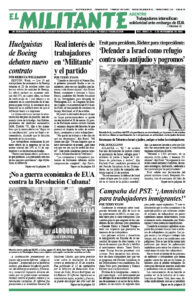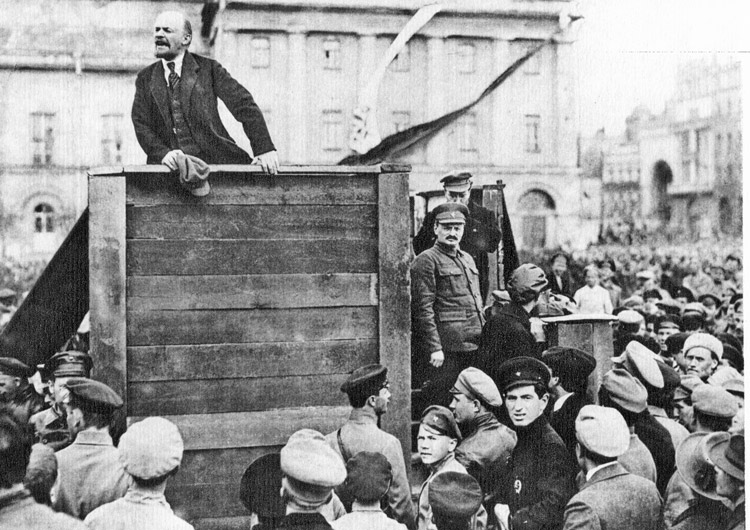Pathfinder Was Born with the October Revolution by Mary-Alice Waters is one of Pathfinder’s Books of the Month for October. The excerpts below are based on Waters’ presentation to a conference on “Political and Social Publishing in the 1990s,” held Feb. 2-3, 1998, in Havana. She was one of several speakers who addressed the meeting, sponsored by Casa Editora Abril, publishing house of the Union of Young Communists (UJC) of Cuba. Copyright © 2000 by Pathfinder Press. Reprinted by permission.
Pathfinder Press was born with the October Revolution. As a publishing house, our direct line of continuity goes back to the earliest publication in the United States of speeches and writings by Lenin, on the eve of the 1917 revolutions in Russia. That is when magazines like the International Socialist Review, produced in the United States by left-wing militants in the Socialist Party, began publishing articles by the Bolshevik leader.
Following the victorious October 1917 insurrection of the workers, peasants, and soldiers of the tsarist empire, which opened the road to the first socialist revolution, revolutionary-minded working people the world over sought to understand and follow the example of the first worker-bolsheviks. By 1919 a regroupment of left-wing Socialists, members of the Industrial Workers of the World, and others had come together in the United States to found something truly new — the communist movement in North America, whose explicit goal was to emulate the Bolsheviks. Through many and varied channels they began to publish the periodicals, pamphlets, and books that for the first time in the twentieth century brought to the working class in our hemisphere a communist perspective that drew on the toilers’ initial experience of taking power, defending it, and using it worldwide.
I start with this because it is the clearest way I can explain what guides the editorial policy of Pathfinder to this day. For more than eighty years, Pathfinder and its various predecessors (from Merit and Pioneer, all the way back to the Literature Department of the Workers Party of America) have had one and only one objective: to publish and distribute as widely as possible the books, pamphlets, and magazines that are necessary to advance the construction of a communist party in the United States — an objective inseparable from the building of a communist movement internationally.
From 1917 to today, we have sought to defend a course true to Lenin’s leadership of the Russian Revolution and the early years of the Communist International. Lenin’s political trajectory was the opposite of the course that later became identified with the Stalin-led Communist Party of the Soviet Union — the consequences of which are being registered in the colossal events of recent years that continue to unfold throughout Central Europe, the Balkans, and the former Soviet republics. Pathfinder has always prioritized printing works created by revolutionists who exemplified Lenin’s internationalist and proletarian course in deeds as well as words.
We begin with the world and the ongoing facts before us, with the most important challenges of the world class struggle, thinking about how to strengthen the fighting vanguard of the working class so it is better armed to understand the world in which we live; to understand the history of the modern working-class movement; to become more conscious of its strength and historic responsibilities; and to chart a line of march toward taking power in order to open the road to the construction of socialism.
“Communism is not
a doctrine, but a movement”
—Frederick Engels, 1847
We have always subscribed to Engels’s famous response to Karl Heinzen, written in 1847 a few months before Karl Marx and Frederick Engels drafted the founding document of the modern workers movement, the Communist Manifesto. “Communism is not a doctrine, but a movement,” Engels wrote. “It proceeds not from principles but from facts. Insofar as it is a theory, [it] is the theoretical expression of the position of the proletariat” in its struggle with the bourgeoisie and the “theoretical summation of the conditions for the liberation of the proletariat” and its allies from exploitation and oppression. …
Since 1928 when the Militant first began publishing — and 1931 when Pathfinder’s predecessor Pioneer Publishers produced its first title — there has always been a close working collaboration between the newspaper and the publishing house. Many of the materials that eventually find their way into Pathfinder publications first appear in the pages of the Militant. It couldn’t be otherwise with a publishing house that is always in the thick of struggles and seeking to promote a clear class perspective.
From the beginning of the Cuban Revolution, for example, the Militant has been the main periodical in the United States that published important documents and speeches by leaders of the Cuban Revolution. These were often then rapidly reprinted by Pioneer Publishers as pamphlets and used widely by the active defenders of the Cuban Revolution both in the United States and Canada, many of whom organized themselves during the revolution’s opening years as the Fair Play for Cuba Committee.
In the days before photo-offset printing, it was especially important to be able to reuse the hot-lead type set for the newspaper, which was by far the costliest element in the printing process.
Pamphlets such as The Second Declaration of Havana were first published this way, for example — another title that Pathfinder has kept continuously in print, in this case since 1962. Tomorrow, in fact — February 4 — we will be marking the 36th anniversary of that call to action to the toilers of the Americas. We still use it widely as one of the best and most basic pieces of literature we have to explain the character of U.S. imperialist domination of Latin America, the inevitable resistance to it, and the place of the Cuban Revolution in that uncompromising resistance.


